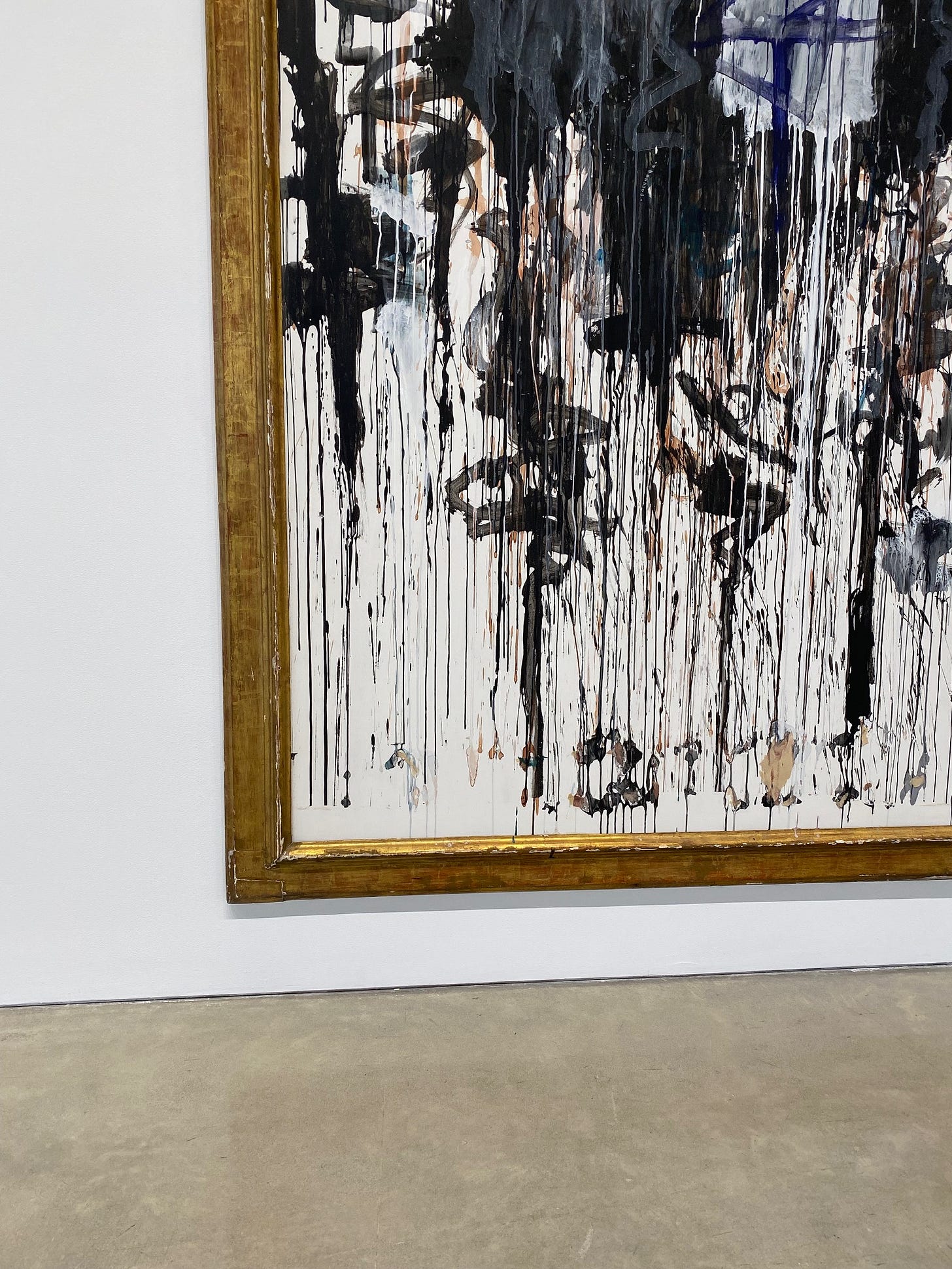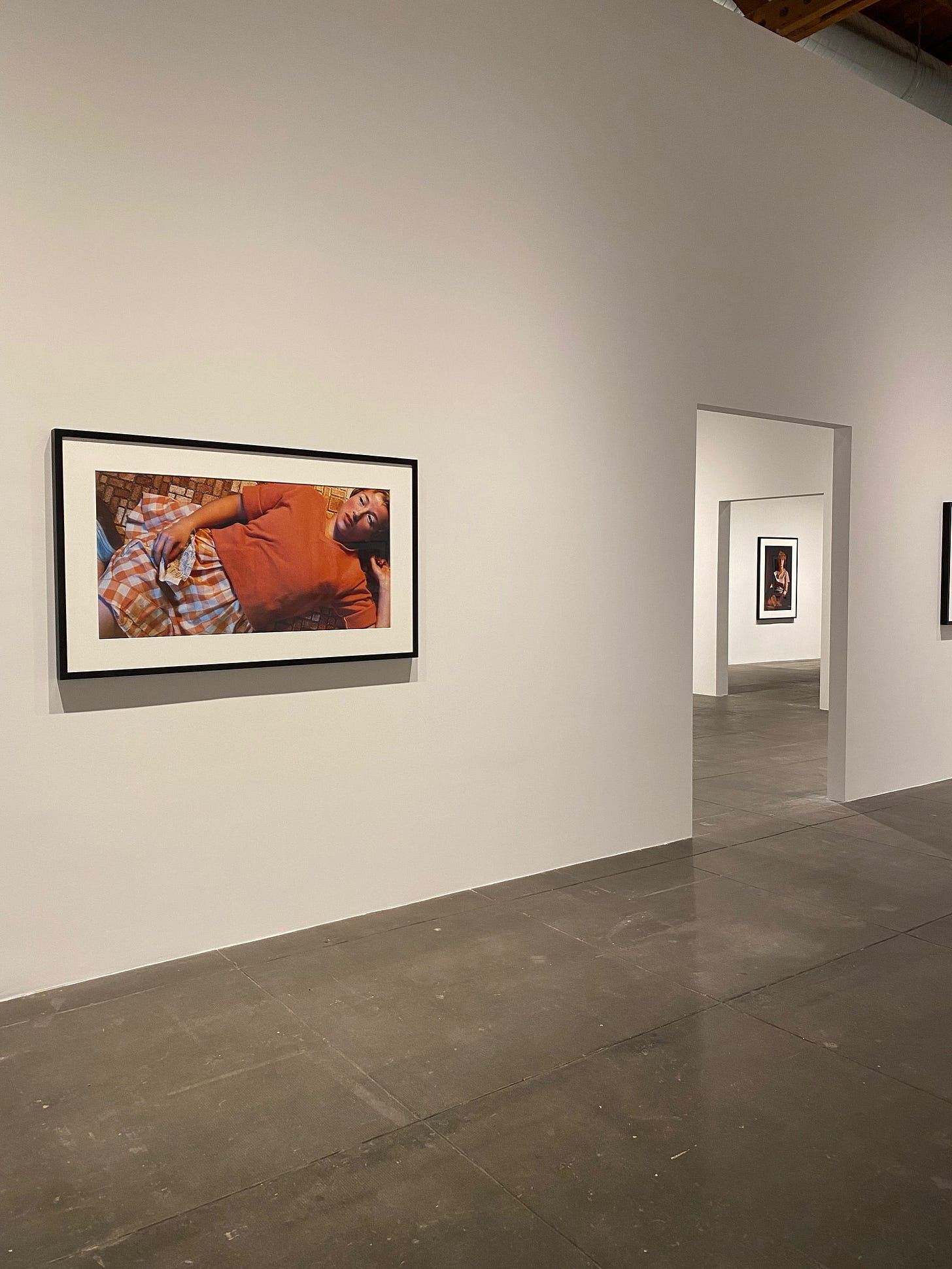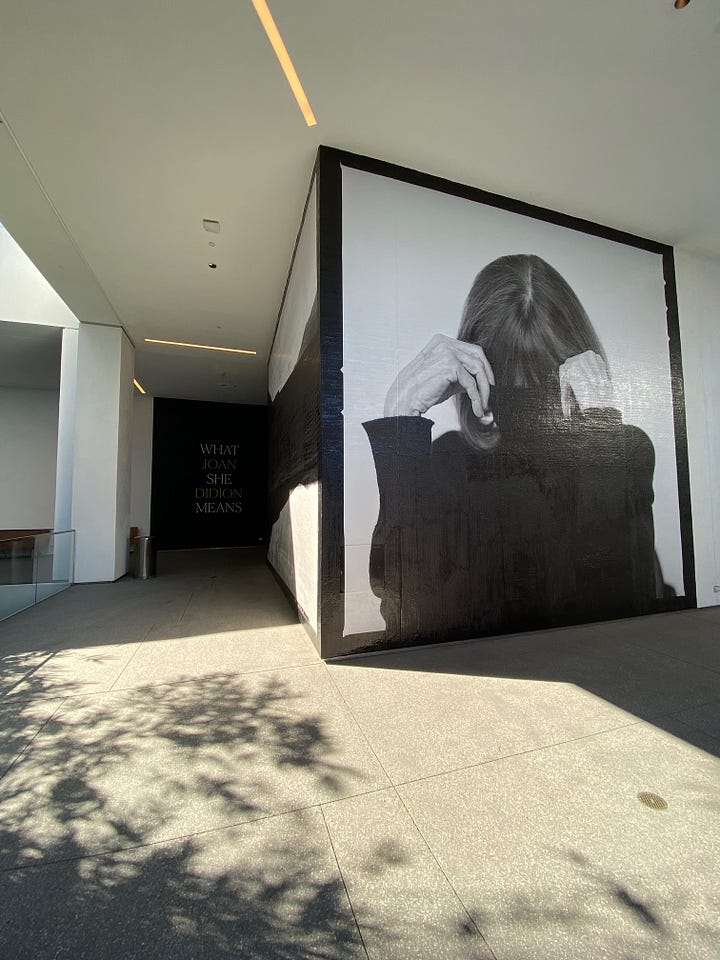
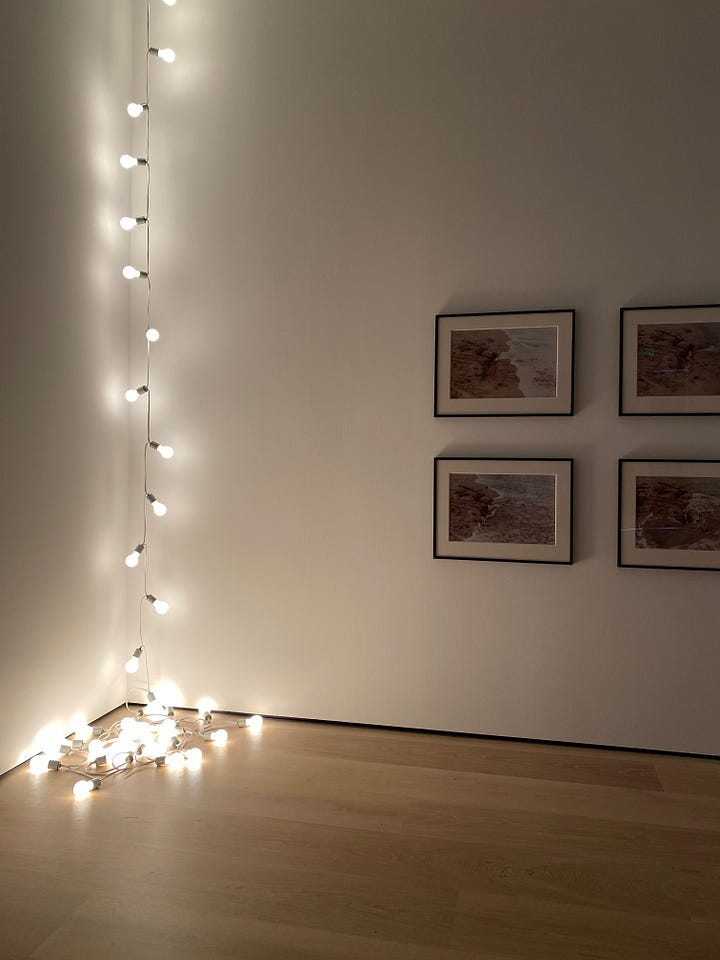
I flew to Los Angeles for a week for work. It had been years since I visited the West Coast, and the skies were so blue and clear and the palm trees so tall and the sunrises and sunsets so colorful it caught me off guard. I felt like a different person in Los Angeles. I took pictures of myself in the hotel mirror and didn’t delete them. Everyone was in a good mood because rain was in the forecast; it was supposed to rain for the second or third time that year. I live in a temperate rainforest so I didn’t understand this, but I was grateful that people were so kind. They liked to talk. I liked to listen. It helped ease the pressure of my work, the long cab rides, the uncertainty around which direction or neighborhood I was in at any given moment. There’s some saying, “Los Angeles is fifty neighborhoods trying to be a city.” Something like that. It feels true.
Anyway, I had one day off from work while I was there, so I hopped in a cab on a sunshiney, bright blue Sunday and went in search of some art.
I had been having anxiety dreams about work and domestic life, which always means I have been art-starved for too long; my soul cried out for it. I had one goal: start at the Joan Didion exhibit at Hammer Museum and see where the afternoon guided me. Friends urged me to visit The Getty, to which I kindly replied that I had time but I didn’t have that much time, and besides, Joan was my focus. My priority. My North Star. I went in search of her.
The Hammer Museum is free. You walk “into the museum,” where they give you a blue sticker that you affix haphazardly to yourself, and then immediately you are outside again, in a lush open-air courtyard, where there is a cafe and funny roly-poly seats for kids (but mostly occupied by adults) and concrete benches and plants. You take the wide stair up to the second floor, where there are entrances to various galleries, each with their own multi-room exhibits. I curved around the second story walk and suddenly I was face to face with her, the full height of a storied building: Joan, as captured by Brigitte Lacombe, Joan obscured by her turtleneck, her aged but recognizable hands, her fine, straight bob. Joan Didion: What She Means printed in large letters next to her photo. The letters guided me around to the gallery door, which I had to pull on with some effort, and I stepped inside to quiet, hushed voices, padded footsteps, and somewhere—in another room—the faint sound of music.
There’s no specific place to begin. You begin where you want. You see when you’re ready to see.
To really immerse myself, I slipped on my headphones and found a recording of the writer & critic Hilton Als in conversation with Joan, and for the next thirty minutes I meandered, her voice and his voice in my ears.
The exhibit featured installations by many artists as well as small domestic items, photographs and memorabilia that narrated Joan’s life in distinct sections of where and when she lived. One piece drew many observers to it: a table arranged with an ashtray and some trinkets, as well as a record player spinning a Joni Mitchell record. Underneath the table, stacked and leaned against one of the legs: a sparse collection of albums. I noticed a number of people smiled at this: they got this reference, they recognized the music, something they had in common with one of the most notable and influential writers of our time. Something they could understand.
It’s a performative act to look at art with others. We’re never truly studying a work on the wall when someone else is there. How can we let ourselves go and absorb what’s in front of us, letting it sink beneath the surface, let it affect us, have a relationship with it, when we are constantly aware of our own body occupying space in relation to others? We’re still in survival mode. We’re still in polite society. Our brains scan the room, scan the security guard, scan the man standing next to us, scan the group of students who inch closer.
Even when there’s no distinct queue to join and gain a clear but brief line of sight to a work of art, we still can’t manage to close the space between us and the work because of rules we were taught (sometime? somewhere? by whom?).
Approach a work of art and scan it at a reasonable pace.
Don’t touch the art. Don’t get too close to the art. Don’t let the art get too close to you.
Look serious, contemplative.
Promptly step to the right or left. Proceed to the next work.
I can’t recall every piece in that exhibit because I didn’t have time to be impressed upon by the work before I needed to scoot to one side or another and move on. But I can tell you I stopped in front of John Koch’s Portrait of Dora in Interior and felt horribly, inexplicably lonely. I stopped in front of a photograph of Joan’s California living room, taken sometime in the 60s, and noticed the soft nature of daylight. In front of both of these pieces I allowed myself to linger. No one was around demanding to get closer, waiting for me to move. Instead, I was able to take some time and get closer to the artworks; I didn’t analyze them but felt them. I asked myself, what does this feel like? And I became overwhelmed with nostalgia and longing. A simpler time, years ago, when I didn’t know what lay ahead of me—all the pain, heartache, violence, betrayal, hope, routine, love, contentment—and all I had within me was the feeling of what I could be. In that moment, I felt that again, all of it, the things I could be and could have been and wasn’t, before the feeling dimmed. In the other room, the record stopped. The conversation between Hilton and Joan came to an end in my headphones. Shaken, I quickly made my way to the door and upon my exit, overheard the guard radio another person I would never see, asking to send a professional who could flip the record over.
After lunch in the sunshine and a glass of wine to compose myself, I took a cab to Gagosian in nearby (well, as nearby as anything can be in L.A.) Beverly Hills. I had learned of another exhibit by one of my favorite artists, Cy Twombly, where I would be able to see works from the last decade of his life. When I arrived at Gagosian, the streets and sidewalks around me were empty, and the buildings seemed empty except a bustling taco place a block away. I couldn’t see any movement behind the gallery’s semi-opaque windows, but found the front door unlocked. I opened it and peered in, and noticed a person sitting behind a desk.
“Excuse me, are you closed?” I asked them.
She smiled and shook her head. “No, please come inside. Enjoy.”
There is no pomp and circumstance with Gagosian, which houses modern art. The main floor is large—a simple, configurable space—with high ceilings spanning a couple of rooms. The second floor grows tighter, with many doors leading to little administrative offices and meeting rooms and smaller exhibit spaces. The afternoon light filtered through the windows in such a way that the gallery felt the exact opposite of Hammer’s windowless and womb-like warm gallery. This was bright, peaceful, organic. There was no grand signage to signal the Cy Twombly exhibit, instead I turned the corner from the desk and found myself in the first of two great rooms, face to face with his saturated brush strokes on canvas: wild, happy, self-made as one can be at the height of Bacchanalian pursuits.
Across the room stood a single security guard. She had another company’s tag on her uniform. She politely nodded and went back to scanning and stepping between both of the great rooms.
There was no one else here. I couldn’t believe it. I walked around the artist’s sculptures, making slow figure eights between the pieces in each section. Where was everyone? Weren't they aware of what was here?
But here I was, completely alone with Cy. So I took my time.
There was nowhere to hide. Nothing to scan or survive. No line of people waiting for me to move. I was simply tasked to be with the art. To be here, to be still with what Cy might be trying to tell me through large loops and swaths of paint dripping down past its borders. Standing still, I lowered my shoulders, stood face to face with the painting, and took in the work. Everything dropped away. I felt the whole ecstasy and comedown of life, of each breath, how it feels to be half-trapped and constantly unfolding in this canvas, this frame of my own making.
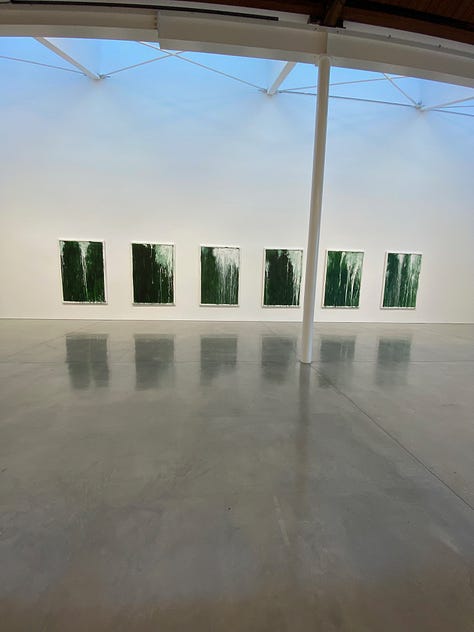
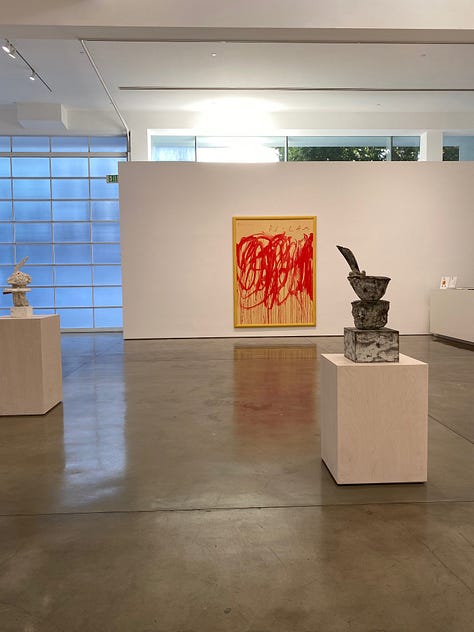
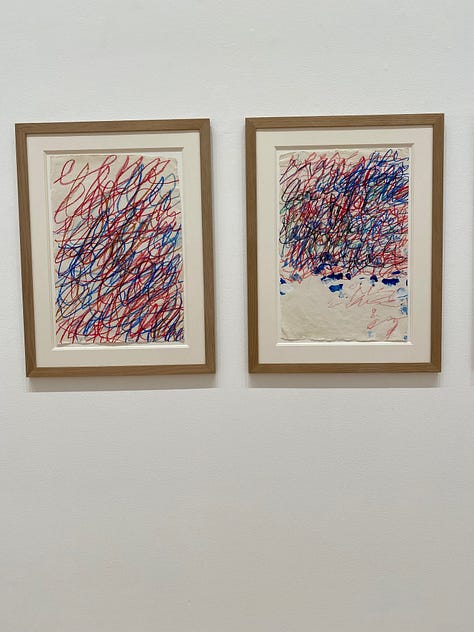
My face grew hot, I could feel a flush red rising up my neck, and my eyes began to water. I turned away from the guard and sniffed into my sleeve, and shook my hands furiously at my sides to wave it away. No, it was happening. I had felt this before, once in the High Museum when I came face to face with Benny Andrews’ Revival Meeting, and once in the back room of Galerie d’Orsay, when the owner unveiled for me a new landscape by Luc Leestemaker.
I couldn’t stop it. It was going to happen. I broke open.
Tears streamed down my face. I steadied myself to keep from buckling in the middle of the room, and I cried. I just…cried.
I grew up in an artless town. I don’t write this to sound dramatic. There was simply no access to art, curated or otherwise. We had a little community theatre where we could see plays when we could afford to, which was not often. I spent most days at the library in the little town square, flipping through a couple of coffee table art books. My father once sent me an Art Nouveau book that I coveted and eventually ripped pages from to tape on the walls. My mother scraped together a little extra money to buy me some art lessons by a friend of hers. But for the first half of my life, I didn’t walk into any art galleries. At nineteen, through what can only be described as a Dickensian turn of events, I flew to Oxford to study Shakespeare’s works as well as art history and become “somebody.” There, I went to opera houses, ballets, quartet parties. Museums and galleries stood on every corner, in nearly every town and city. As soon as I finished studies, I ran to the train station in search of art and walked into as many spaces as I could. I let art wash over me, I painted and drew pieces myself, and I began to feel everything in every inch of my body. Life hummed electric and full because of what others before me had created, what others around me were creating, in ways I could not predict nor fathom. In the dark mezzanine at the symphony I would look back and see some faces wet with tears, and wondered why it seemed acceptable to cry in the darkness but not in the daylight in front of a sculpture. One of the gifts of human life is the experience of intimacy in all its forms and sources and side effects (crying, moaning, laughing, screaming, gasping for breath, flutterings of the heart, epiphanies, fears, wisdom). It took all of my being to understand art, to learn what I liked and what I didn’t like but could appreciate. It demanded that I feel it. It reflected truths that I could see disturbed my friends and family. It broke open every facet of what it’s like to be human.
Now, here I was again, feeling all of who I was—including the parts I was supposed to be ashamed of and felt no longer ashamed—and feeling a piece of Cy’s journey as man and artist and feeling the deliciousness of secrets imparted to us like a friendship honeymoon, and also the sadness of mysteries, of things unsaid, that one person obscures from another but for good reason. With a splotchy, tear-stained face I giddily walked through each room several times. I had all the time in the world. The guard kept a distance. Later, when a young couple strolled into the gallery, I thanked Cy, I thanked the guard, I thanked the front desk manager, and I left.
From Gagosian, I took another cab across town to the Arts District, where a friend had asked me to meet her at Hauser & Wirth for a cocktail. By now the shadows stretched long together, one stop light after another.
Hauser & Wirth is an open-air complex with galleries, a bar and restaurant, bookstore, shops. There are chickens in a coop, too. Heart full and spilling over, I hugged my friend for several minutes and we sat for a cocktail. It had been decades since we had seen each other in the artless town we grew up in.
When we finished our drinks it was shortly before 6pm, and the exhibits were scheduled to close, so we ran to the nearest one. Inside, in the dark, we watch a bonkers installation by Martin Creed, twice. We then ran into the next exhibit, but I wasn’t prepared for what it contained.
“Cindy Sherman,” I breathed. An entire showcase of her work. 1977-1982.
Cindy Sherman is one of my favorite artists, and I couldn’t quite believe my luck. It was oddly silent, we noticed, and no one was here save for one young guard stationed by the door, who kindly reminded us the exhibit was going to close soon. I grinned at my friend and we breezed through the rooms, one by one, taking in the exhibit as an overview, before we split off to focus our own curiosities. I began with “Untitled Film Stills,” a collection of 8x10 inch black and white film stills, a fictional narrative from an actress’s career. I took in the whole story in front of me, Cindy disguised and enveloped in this world of her own making, a different person in each photograph. Among these: the only photograph in the entire exhibit that contained two people. Who were they supposed to be, and why? What was the significance of this second person, when in Cindy’s works the artist always appeared alone? The artist being near to herself, the muse, I suppose? I moved into the next room.
“Centerfolds,” a project Cindy completed in 1981, is composed of a dozen large scale horizontal works—each a ‘centerfold model,’ who is Cindy of course, and yet not actually her—and designed to make us feel uncomfortable in their tension between the concept of what is erotic and awakened, and what is objectified and consumed. I watched her disappear over and over into these other women, each little moment captured at an awkward angle, signifying a bigger life off camera. I wondered if I had evolved through my own series of Catherine-but-not-Catherines, personas with obsessions so deep I had convinced myself and others it was the real me, when I was still figuring out who the real me was.
I heard my friend’s footsteps turn the corner into “Untitled Film Stills.”
Alone in the quiet room with the centerfolds, there it was again: the rushing warmth in my throat, tears welling up. Fuck, not again. I didn’t shake it away this time but instead let a sob slip between my lips, and the sharp intake of breath echoed off the wall. I felt close to something, but what I couldn’t name. Here I was, alone with all she wanted me to feel in this body. I felt the years’ long weight of emotional and physical labor Cindy went through to create subjects we, the audience, would want to get to know but could never truly know, because they were anecdotes of human-ness. After all, we are only a sum of moments.
Free access to art is necessary and I hope it never goes away. It is a great equalizer of us all when we’re allowed to have this universal experience. But to also access works of art where we can be still with them, “alone” with them, does something else to us entirely. We don’t have to be in solitude, we just have to figure out how we allow the rest of the world to drop away when in the presence of art, to feel instead of to analyze, to normalize emotion in “polite” society. Imagine what we would unlock, what we would let bubble up to our mouths from the depths of ourselves, if we weren’t afraid to let this happen, to slow down and feel a deeper intimacy with ourselves, to let art reflect back the all the great and ecstatic and terrifying truths we have been avoiding.
My friend appeared next to me. She started to say something and suddenly it went pitch black.
“Oh my god!” she said. “I guess security thought no one was in here.”
They had turned off the lights and locked us in. We laughed nervously in the dark, then made our way to the door, where we waited until someone came by. We knocked on the glass and gestured that we were stuck in here. It wasn’t so bad. For a brief moment, as they fiddled with the bars at the bottom of the gallery door, I felt the thrill of being locked in overnight with a room full of Cindy Sherman photographs, my personal Mrs. Basil E. Frankweiler fantasy.
They released us. Free and laughing, we strolled out into the clear evening in search of what we wanted next.
“…you get the sense that it’s possible simply to go through life noticing things and writing them down and that this is OK, it’s worth doing. That the seemingly insignificant things that most of us spend our days noticing are really significant, have meaning, and tell us something."
—Joan Didion
What I’m spinning: Bird and Diz, by Charlie Parker and Dizzy Gillespie
What I’m reading: Blind Willow, Sleeping Woman by Haruki Murakami

